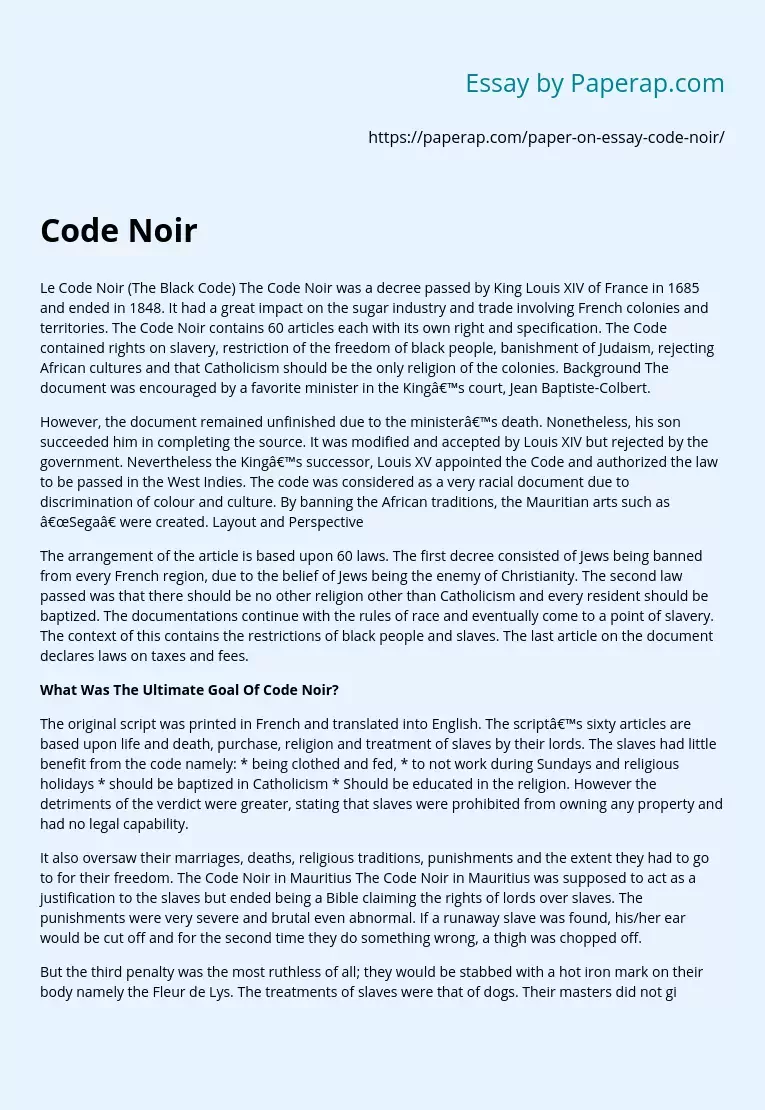Le Code Noir (The Black Code) The Code Noir was a decree passed by King Louis XIV of France in 1685 and ended in 1848. It had a great impact on the sugar industry and trade involving French colonies and territories. The Code Noir contains 60 articles each with its own right and specification. The Code contained rights on slavery, restriction of the freedom of black people, banishment of Judaism, rejecting African cultures and that Catholicism should be the only religion of the colonies.
Background The document was encouraged by a favorite minister in the King’s court, Jean Baptiste-Colbert.
However, the document remained unfinished due to the minister’s death. Nonetheless, his son succeeded him in completing the source. It was modified and accepted by Louis XIV but rejected by the government. Nevertheless the King’s successor, Louis XV appointed the Code and authorized the law to be passed in the West Indies. The code was considered as a very racial document due to discrimination of colour and culture.
By banning the African traditions, the Mauritian arts such as “Sega” were created. Layout and Perspective
The arrangement of the article is based upon 60 laws. The first decree consisted of Jews being banned from every French region, due to the belief of Jews being the enemy of Christianity. The second law passed was that there should be no other religion other than Catholicism and every resident should be baptized. The documentations continue with the rules of race and eventually come to a point of slavery.
The context of this contains the restrictions of black people and slaves. The last article on the document declares laws on taxes and fees.
The original script was printed in French and translated into English. The script’s sixty articles are based upon life and death, purchase, religion and treatment of slaves by their lords. The slaves had little benefit from the code namely: * being clothed and fed, * to not work during Sundays and religious holidays * should be baptized in Catholicism * Should be educated in the religion. However the detriments of the verdict were greater, stating that slaves were prohibited from owning any property and had no legal capability.
It also oversaw their marriages, deaths, religious traditions, punishments and the extent they had to go to for their freedom. The Code Noir in Mauritius The Code Noir in Mauritius was supposed to act as a justification to the slaves but ended being a Bible claiming the rights of lords over slaves. The punishments were very severe and brutal even abnormal. If a runaway slave was found, his/her ear would be cut off and for the second time they do something wrong, a thigh was chopped off.
But the third penalty was the most ruthless of all; they would be stabbed with a hot iron mark on their body namely the Fleur de Lys. The treatments of slaves were that of dogs. Their masters did not give a care if something bad happened to them. Their nutrition was limited and therefore the slaves themselves had to cultivate their own food in secret. However, not all masters were like that to their slaves. Some did care for their workers and gave them a proper living by gifting them appropriate clothing and food. Abolishment
Slavery was abolished in France in 1794 and a few decades following that, the Code Noir was also eradicated in 1848. The Code Noir had remained intact for 163 years. Although slavery was obliterated in 1834, the Code Noir stayed for 14 years and then stopped. The slaves who will continue to work would not be referred to as slaves but as apprentices. The Code Noir only had two goals that was: – To give slave owners rights to their slaves – To boost the morality of the slaves Although the Code Noir was not always obeyed and followed, it remained a very important aspect to French Colonies.
Legacy Even if the code was removed, the phase of this period was adopted into many books and documentaries. A few of these books have been published in Mauritius specifically, “Gorges” by Alexandre Dumas. The Code Noir remains a legacy of the French Revolution in Mauritius; nonetheless it depicts the suffering and torture of slaves while working. It also reflects the pain of Mauritius’ ancestors and toilers. The Code Noir serves as an example to our people and a dedication to all those who gave their time and effort into making this island what it is today.
What Was The Ultimate Goal Of Code Noir?. (2019, Dec 05). Retrieved from https://paperap.com/paper-on-essay-code-noir/

